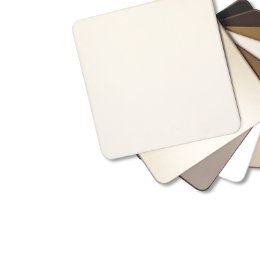Five things to know about metal composite panels
Durable, low-maintenance, and easy to fabricate, metal composite panels provide versatility for façade design. AIA partner ALPOLIC provides an overview of possibilities.
Architects face a litany of requirements when it comes to designing facades: building codes, sustainability, dynamic design intents, to name a few, while also needing to ensure they are easy to fabricate, install, and maintain and help buildings stay on budget. Metal composite materials (MCM) offer a solution to enabling architects to realize visions that were impractical or wholly impossible just a few decades ago.
How they’re made
Metal composite materials are produced by continuously bonding two thin sheets of painted or natural metal to either side of a thermoplastic core. The core produces a sheet that is lighter in weight and easy to fabricate, flat, and durable. The core material is either a traditional polyethylene or a mineral-filled fire retardant, suitable for buildings above 40 feet from grade. The finished product is available in thicknesses of 3mm, 4mm, or 6mm, with 4mm being the most commonly used. Standard panel dimensions are 50 inches or 62 inches wide and 146 inches or 196 inches long, with custom sizes also available.
How MCMs contribute to sustainability
Most MCMs have high recycled content, providing potential LEED points under Innovation. Most architectural stock colors earn a “Cool” rating from the Cool Roof Rating Council (CRRC) by reflecting heat instead of absorbing radiant energy, reducing energy usage. In addition, MCM manufacturer ALPOLIC uses a factory-applied die-coated paint system that virtually eliminates harmful VOCs before they enter the atmosphere. ALPOLIC also was first in the category to promote product transparency declarations by publishing environmental product declarations.

Finish flexibility
Architects can choose from a broad range of possible finishes: solids, micas, metallics, prismatic, decorative metals, shimmer effects, stone, timber, pigmento, matte, and more. It’s even possible to provide a multi-color finish on a single panel. If a standard finish doesn’t quite capture the architect’s intent, custom-color matches can achieve nearly any color imaginable.
In addition to painted aluminum skins, a variety of other natural metals can also be used, including copper, stainless steel, zinc, and titanium. When installed on a building, these corrosion-resistant skins are visually indistinguishable from solid sheets of the same metals. Copper and zinc develop a natural patina over time, while stainless steel and titanium maintain their initial appearance indefinitely.
Endless fabrication possibilities
Versatile and easy to fabricate, metal composite materials can be used to create a practically unlimited world of complex forms and shapes. The thermoplastic core makes MCMs lighter in weight with no loss in rigidity. Composite materials are designed to be affordable and easy to install and are stable, dampen vibration, are easy to maintain, and won’t distort or “oil can” due to differential expansion and contraction in changing weather conditions.
For example, the Calgary Central Library in Alberta (above), by Snohetta and DIALOG, features ALPOLIC MCM in combination with glass units to create a crystalline geometry on the facade. Along with the ease of fabrication to create the one-of-a-kind visual, the metal composite panels are well-suited to the harsh winter weather of the region.
Consider the advantages
Manufacturers have continued to innovate with MCMs since they were first introduced a half-century ago. Advancements in image transfer have enabled realistic patterns of stone or timber to provide the aesthetic beauty of nature without the limitations of weight, maintenance, and cost. Pigmented zinc and tinted anodized aluminum let the brilliance and texture of the natural metal shine through subtle hues. Precision color matching with advanced fluoropolymer paints gives you the color you want with a warranty of up to 30 years. Even fabricators are pushing the limits, creating complex forms to address new challenges in the areas of acoustic design and extreme weather conditions.
Building design comes with several considerations and design challenges. MCMs offer a versatile, sustainable, and cost-effective solution.







